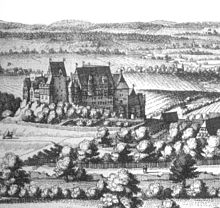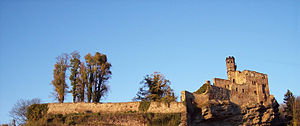Hardenberg Castle (Nörten-Hardenberg)
| Hardenberg Castle | ||
|---|---|---|
|
Hardenberg castle ruins |
||
| Alternative name (s): | Hardenberg front and rear buildings | |
| Creation time : | around 1101 | |
| Castle type : | Höhenburg, rock castle | |
| Conservation status: | ruin | |
| Standing position : | Ministeriale | |
| Place: | Norten-Hardenberg | |
| Geographical location | 51 ° 37 ′ 47.5 " N , 9 ° 56 ′ 56.5" E | |
|
|
||
The castle Hardenberg is the ruin of a rock castle on a cliff top with steep rock walls in Norten-Hardenberg .
Building description
It is a double castle, which has been named in the front and rear buildings of Hardenberg. One line lived in the older part of the castle complex, the so-called rear building. The other line inhabited the northern part as the front house. To keep the peace and to keep the obligations, both parties concluded a truce . Both areas of the castle were separated by a section ditch over which a wooden bridge led. The usual keep not have both parts of the castle as this was not common in castles ecclesiastical property. Access is only possible from the north side over the moat. Today, the ruin of the castle cannot be entered without supervision because of its dilapidation and other dangers. Visits and the inspection of the observation tower are possible as part of guided tours.
history
middle Ages
The castle was founded by the Archdiocese of Mainz to monitor two trade routes . Around 1101 the fortified complex was first documented as "Vestes Haus". In 1098 the Archbishop of Mainz Ruthard sought refuge in the castle from King Heinrich IV (from the Salier family ). In the middle of the 13th century, the Lords of Rosdorf were ministerials of Mainz. In 1287 the castle was besieged by the dukes Heinrich, Albrecht and Wilhelm von Braunschweig. In the same year it was pledged for a large amount. It was not by chance that ownership fell to the Lords of Hardenberg , who had often been favored by the Archbishops of Mainz before. The Hardenbergers acquired considerable goods from them, including the castle and the village of Nörten in 1287.

The Lords of Hardenberg were now the owners of the castle. They used to call themselves de Novalis . Bernhard de Novalis had the sons Günther and Hermann. The undisputed position that the Lords of Hardenberg had in the following years also resulted from the fact that Archbishop Heinrich III. von Mainz confirmed to them the pledge of the castle and the village of Nörten in 1345. His successor Gerlach did the same in 1357 . Over time, the Hardenbergers developed complete freedom of action and probably lived in the castle alone. In 1375, Duke Albrecht von Braunschweig-Grubenhagen committed to protecting von Hardenberg's life for life, and in return he was given free access to the castle. In the meantime, two lines of the Hardenberger had developed, which sometimes led to disputes regarding the castle. A division of the family property took place in 1409 by Dietrich von Hardenberg, which resulted in the front and rear building branches. The division also affected the castle, in 1430 there was a dispute between Hildebrand von Hardenberg and his cousin Dietrich, whereby it was also about the graven to Hardinberghe twyschen syner borgh vnde myner, dar ek mein, dat der graven myn were . According to a legend , a feud led to the coat of arms of the von Hardenberg family, the boar's head . When the castle was besieged by the Lords of Plesse Castle , a nocturnal attack should have occurred. A boar is said to have woken the castle residents with loud grunts. As early as 1403, the von Hardenberg family split into two camps on the basis of an inheritance contract. This also had an impact on their aristocratic residence, which became a double castle.
Modern times
In a mediation by Duke Heinrich von Braunschweig-Wolfenbüttel , over half of the House of Hardenberg between Cord von Schwichelt, Hans von Steinberg and Dietrich von Hardenberg, as well as Hans von Hardenberg, Cord von Schwichelt is awarded half of the House of Hardenberg, but with the comment de overlicheyd unde de rechticheydt of the Archbishop of Mainz. In 1607, the Archbishop of Mainz, Johann Schweikhard, announced to the Hardenbergers that he wanted to redeem the Hardenberg pawnshop again. However, they refused to hand them over. Only a recess from the year 1744 settled the dispute between the two parties by stating that the Archdiocese of Mainz would no longer dispute their private property in the Hardenberg and Geismar houses with the von Hardenberg family. The Count's Head of House described how the front building gave way and collapsed during a major thunderstorm in March 1698. The “Vorderhaus” line moved to nearby Göttingen and moved to the newly built Hardenberg Castle at the foot of the mountain around 1710 . The "Hinterhaus" line left the castle in 1720.
The castle was renovated in 1840, but a drawbridge, an entrance gate and a new tower in the neo-Gothic style were also built. From 1962 the castle ruins were renovated again and excavations were carried out.
today
Hardenberg Castle was a popular destination for Göttingen students well into the 20th century. On May 13th, 1848 the fraternity Hannovera was founded in an inn in Nörten , which still exists in Göttingen today. Accordingly, representations of the castle ruins can be found on a large number of images.
From 1998 on, the building structure of the castle began to be secured. In the year 2000, construction-historical studies and archaeological studies were carried out on a residential building with an oven in the front building. It was the younger of the two residential buildings, dating from the 15th century.
The von Hardenberg family own the castle ruins to this day and run a grain distillery in the village , which they founded in 1700. According to its own information, Hardenberg-Wilthen AG is the second largest spirits manufacturer in Germany. There are also hotels and restaurants under the name Gräflicher Landsitz Hardenberg, as well as the implementation of numerous events, such as horse tournaments or an ice rink event in winter. Below the castle ruins on the former estate there are today:
- Hotel operations
- Sales shop and bar for spirits products from the grain distillery
- Castle Park
literature
- Ernst Andreas Friedrich : The castle ruins Hardenberg , pp. 95–97, in: If stones could talk , Volume III, Landbuch-Verlag, Hanover 1995, ISBN 3-7842-0515-1 .
- Hans Adolf Graf von Hardenberg and Alexandra Countess von Hardenberg: The Hardenberg Castle and historic Nörten .
- Sonja König: Today I bake, tomorrow I brew ... in: Archeology in Lower Saxony , pp. 109–112, 2001
- Markus C. Blaich , Sonja Stadje, Kim Kappes: Hardenberg Castle in: The Heldenburg near Salzderhelden, castle and residence in the Principality of Grubenhagen , (= guide to the prehistory and early history of Lower Saxony. 32) Isensee Verlag , Oldenburg, 2019, p. 116– 122.
Web links
- Entry by Jens Friedhoff about Hardenberg Castle in the scientific database " EBIDAT " of the European Castle Institute
- Reconstruction drawing in the medieval state
- Drawing of the castle ruins around 1833 on kulturerbe.niedersachsen.de
- Hardenberg Castle at burgen.de
- Hardenberg Castle at burgenwelt.de
- Hardenberg Castle at burgen-und-schloesser.net
- Göttingen city information: Hardenberg Castle
Individual evidence
- ^ Friedrich Wilhelm Unger: Göttingen and the Georgia Augusta. A description of city, country and people in the past and present for locals and foreigners. Göttingen 1861. p. 233
- ^ Johann Wolf: History of the Hardenberg family. Part 2: With 123 documents . No. 26 . JC Baier, Göttingen 1823.
- ^ Johann Wolf: History of the Hardenberg family. Part 2: With 123 documents . No. 52 . JC Baier, Göttingen 1823.
- ↑ Erhard Kühlhorn: Historical-regional excursion map. Leaf Moringen am Solling . Lax, Hildesheim 1976, ISBN 3-7848-3624-0 , p. 129 .
- ^ Johann Wolf: History of the Hardenberg family. Part 2: With 123 documents . No. 123 . JC Baier, Göttingen 1823.




